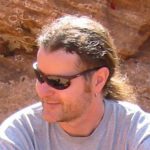Link to Pubmed [PMID] – 16427016
Mol Cell 2006 Jan; 21(2): 271-81
Vinculin plays a pivotal role in cell adhesion and migration by providing the link between the actin cytoskeleton and the transmembrane receptors, integrin and cadherin. We used a combination of electron microscopy, computational docking, and biochemistry to provide an atomic model of how the vinculin tail binds actin filaments. The vinculin tail actin binding site comprises two distinct regions. One of these regions is exposed in the full-length autoinhibited conformation of vinculin, whereas the second site is sterically occluded by vinculin’s N-terminal domain. The partial accessibility of the F-actin binding site in the autoinhibited full-length vinculin structure suggests that F-actin can act as part of a combinatorial input framework with other binding partners such as alpha-catenin or talin to induce vinculin head-tail dissociation, thus promoting vinculin activation. Furthermore, binding to F-actin potentiates a local rearrangement in the vinculin tail that in turn promotes vinculin dimerization and, hence, formation of actin bundles.
